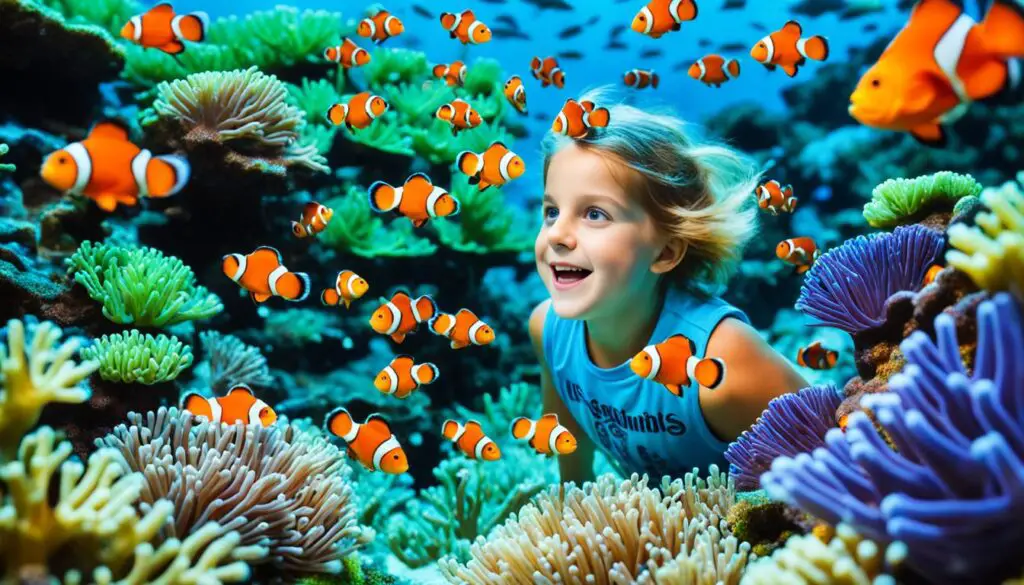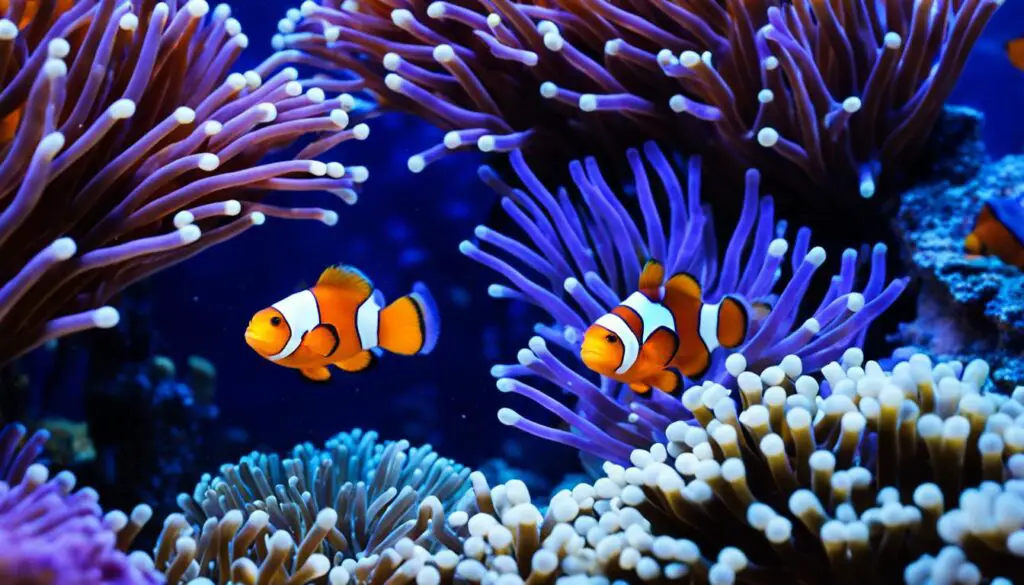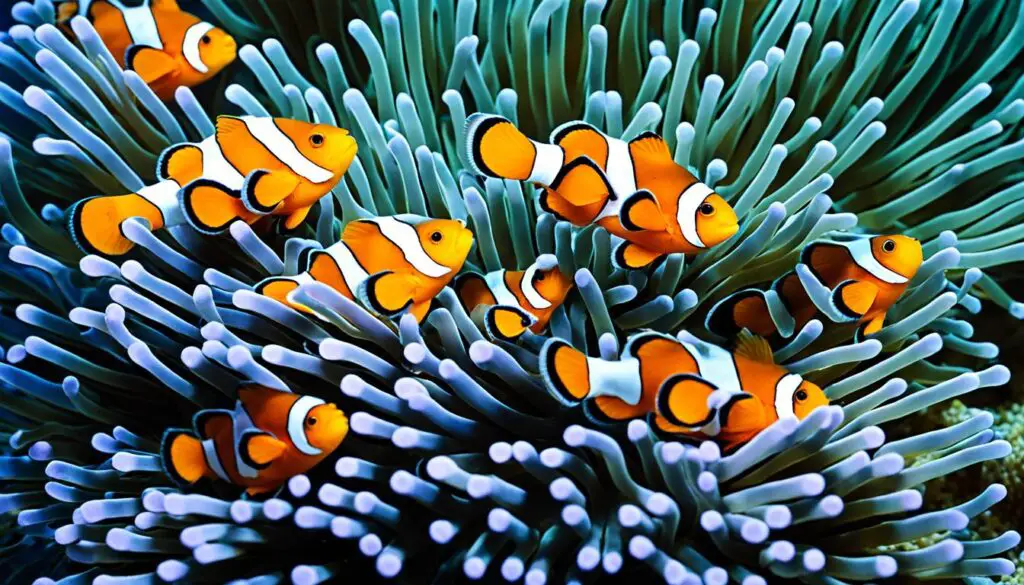Dive into Clownfish Habitat: Creating the Perfect Environment
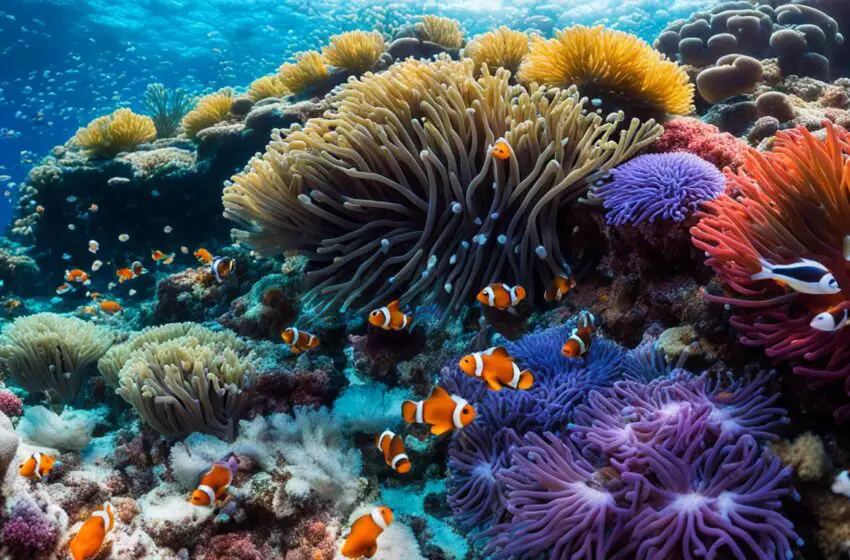
Welcome to the amazing world of clownfish habitat. Here, we’ll look at what it takes to make a perfect home for these bright fish. Clownfish can be found living in the Indian Ocean, the Red Sea, the Pacific Ocean, and off the coast of Australia at the Great Barrier Reef. They like to hang out in shallow waters near reefs. This is where their favourite homes are, certain types of anemones.
Clownfish and anemones have an incredible mutual relationship. The anemones protect the clownfish and give them food. In return, the clownfish help by providing nutrients from their waste. This creates a balanced ecosystem that they both need to thrive.
When it comes to keeping clownfish in tanks at home, some popular types are the ocellaris and the true percula. Others are the tomato, maroon, Clarkii, and pink skunk. It’s very important to get the tank size right. Smaller clownfish need a 20-gallon tank, but the big ones need a 50-gallon or larger.
Anemones are usually used as homes in tanks, but you can use things like torch coral as well. At FantaSEA Aquariums, we’re experts at putting together jaw-dropping tanks. This is not just for clownfish but for all sorts of amazing sea creatures.
Key Takeaways:
- In the wild, clownfish live in various places in the Indian and Pacific Oceans, including the Great Barrier Reef.
- They choose to live in the shallower parts by reefs and have special relationships with certain anemones.
- When setting up a tank for them, the size matters a lot. Don’t forget there are other things besides anemones they can use for homes.
- At FantaSEA Aquariums, we’re really good at making aquariums that are not only great for clownfish but other sea life too.
Clownfish Diet and Behavior
Clownfish eat a mix of foods, making them omnivores. In the wild, they enjoy plankton, algae, and tiny creatures. This varied diet is packed with the nutrients they need to be healthy and grow.
Clownfish have a cool bond with anemones. They hide in the anemones’ tentacles, which protects them. The fish also eat leftovers from their host’s meals. In exchange, they clean their anemone homes by getting rid of parasites and debris.
But, not all anemones are good fits for clownfish friendships. There are thousands out there, but only a few can house each clownfish family. This makes their partnership extra special.
The mucus layer on clownfish skin helps them avoid the anemones’ stings. This protection keeps them safe from other predators.
Clownfish have an interesting way of reproducing. They’re all born as males. But, some can become females as they grow. This change helps keep their species going.
Conservation Efforts for Clownfish
Clownfish and their homes need our help to survive. They face big challenges from climate change and ocean acidification. These issues can mess up how they stay safe from predators and how they grow. This may harm their numbers.
Protecting clownfish means saving their environment, too. We must cut down on carbon, fish the right way, and tell others about the sea’s problems. These steps are key to a future where these fish thrive.
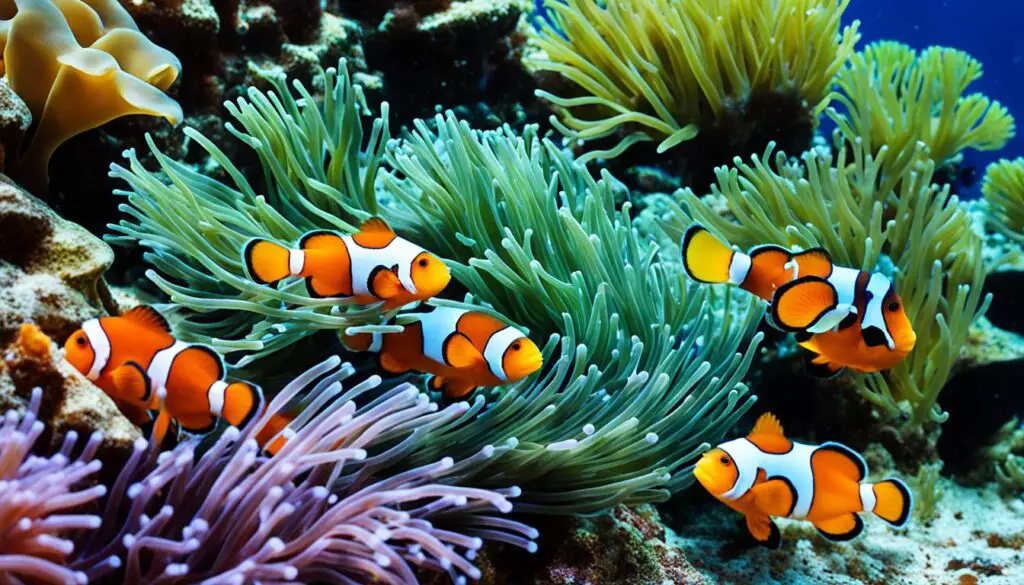
Importance of Protecting Clownfish and their Habitat
The Maldives’ beauty reminds us how human activities can harm our world. Clownfish, loved for their colors, are caught in ways that hurt where they live. This affects both the fish and the small island places that need tourism and fishing.
Coral bleaching, fewer fish, and too much plastic in the sea hurt the Maldives. These problems don’t only affect the clownfish. They hurt the whole sea world. Less fish can mess up the ocean, changing life for everyone living there.
Working together is key. We can get people to care through education. And everyone can help by choosing activities that protect these amazing fish. This includes not overfishing, using less plastic, and being careful when visiting sea places.
Understanding how clownfish and their homes depend on each other is important. By focusing on saving their habitat, we keep the ocean’s life balanced. Our actions now can make sure the Maldives stays a beautiful place for all the lives there, for many years to come.
FAQ
What kind of tank size is suitable for clownfish?
Clownfish need space, with smaller ones in a 20-gallon tank. Bigger clownfish must have at least a 50-gallon tank.
Can alternative hosts be used instead of anemones in aquariums?
Indeed, clownfish can live with other corals like torch coral, not just anemones. It’s all about finding a safe place for them.
What do clownfish eat in the wild?
In the wild, clownfish eat almost anything, such as plankton, algae, and tiny sea creatures.
How do clownfish protect themselves from the stinging tentacles of anemones?
Their skin is covered in a special mucus layer. This layer stops the anemones’ stings from hurting them.
Do all clownfish start as males?
Yes, they do. As they grow, some may change into females if needed in their group.
What threats do clownfish and their habitat face?
They’re facing big problems from climate change and ocean acidification. These dangers make it hard for them to stay safe and healthy.
Why is it important to conserve clownfish and their habitat?
Saving clownfish is vital for the ocean’s health and balance. They are in danger from many human-driven changes.
How can individuals contribute to protecting clownfish and their habitat?
Understanding their life with sea anemones is key. Supporting efforts to protect the ocean and reducing our waste can help them.

